Author Archive
Firstly, I’d like to thank everyone again for all their heart-felt comments and thoughts responding to my previous post. I know I haven’t yet replied to everyone individually, but I have each message saved andthey mean a lot to me.
In some ways, this has been a difficult period and talking about it is something I’ve put off, and shoved to the back of the closet - hence the empty blog. I can be very rational at times (good training from Neil) but to bring to an end something that I worked hard for for two years cost me some tears and there were some lurking feelings of failure alongside as well.
Now though, I’m knitting and spinning again (with a timer set) and my spirits are back up. It’s not a huge blow, I’m now doing something I love just as much, which will keep me physically healthy so that I can keep up the fibre part of my life, just at a slower rate than before. If I had any doubts about the decision, they were put to rest by my osteopath who applauded my news wholeheartedly (but with sympathy of course).
So anyway, I have a new day job - my course starts on Monday! - and I can still knit and spin for about half an hour at a time, I just set the beeper and then make sure I stretch out properly afterwards. I’ve started up the chat-room again, Wednesday nights now and using Ravelry chat through my group there as Lingr is now shut down. There’s also future Spin! designs in progress and I have one or two other ideas in the works too.
Thank you again to everyone who has hung around and supported me through this, and shared your stories with me. It’s been the network of great friends that I have that has kept me going (there were times I was thinking of putting the stash on ebay) and reminded me just how much I really love all things yarny, and that it’s still worth doing, even at half-speed.
Next post will have pictures of yarn I promise!
x x x x
 6 Comments » 6 Comments »
 Posted by: Diane in General
Posted by: Diane in General
Many of you will have figured out by now that things aren’t quite what they used to be around here. I’ve mentioned a few things here and there on Twitter and Rav occasionally, but since I’m still getting occasional questions I thought I’d give everyone the full story in one go.
Almost a year ago I started increasing the level of my freelance work and gradually expanding the spinning/writing/teaching with a view to it eventually becoming a full-time career. In October I quit my part-time day job and started seriously into the task of growing the business even more.
Sadly, it was about the same time that my body started to complain. By Christmas I had a shoulder issue I couldn’t ignore and my back was having problems as well. To cut a long story short, particular issues with my body mean I just can’t keep up the kind of sitting still spinning for hours that I wanted to be doing. Time on the computer isn’t so great either. My Osteopath advised yoga and pilates to strengthen muscles that I’d allowed to become extremely weak (not good in my case) and the first part of this year was focussed on getting my body working again.
It feels great now to be practically pain-free but I still have bad days and I have come to accept that the spinning career is just not feasible. I also rediscovered how much I adore Pilates (I practised for years in Australia) and I dredged up a very old dream of gaining my instructor certification. That is well underway and will become my new day job, hopefully by the end of autumn this year. Keeping my body strong and mobile is the solution to my problems and making this my career will help a great deal.
The spinning will not cease of course, you know me better than that! I will still be teaching in London, and there will be the occasional article published. The part that I really can’t manage is the hours of spinning and knitting involved in releasing designs and testing for tutorials, although there will be new ones occasionally. This blog will still be a Knitting/Spinning blog, and the website will remain with tutorials etc. in place. I will no longer be trying to grow the business, but will be able to relax about just doing as much as I am able to and want to, without worrying that I can’t manage enough for it to be viable.
I hope you all stick around, even though there will be a little less traffic here. I love hearing from you and nothing is going to curb my enthusiasm for all things spinny even if I can’t actually do as much as I’d like.
Thanks, and happy summer!
Diane xx
 17 Comments » 17 Comments »
I have a bad habit of buying knitting pattern books (and any craft pattern books for that matter) and then never knitting anything from them. Well, so far I’ve made two things from Nancy Bush’s Knitted Lace of Estonia and there’s loads more in there that I love. Besides which, I’d knit both patterns again in a flash.
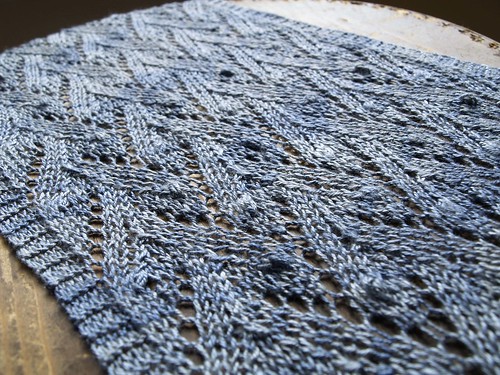
Ruth jokingly claimed this knit even before I’d started, when I was gathering up projects to take on holidays. Well, she had a birthday coming up so I figured, why not? After marathon knitting on Tuesday and blocking under a fan all day Wednesday, I handed it over on time and it was suitably appreciated!

Specs
Yarn: Sheepaints Marisilk silk/seacell blend, from Socktopus
Pattern: Madli’s Shawl by Nancy Bush
Mods: I made it four pattern repeats wide for scarf size, and added the eyelet row to the edging which I saw somewhere on Rav and liked.

This was great yarn, and a great pattern and I would definitely make it again. In fact, it was so hard to give away that I’m considering doing another one just for me!
There has also been spinning:
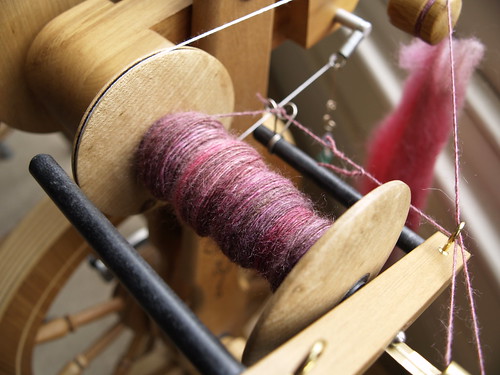
This yarn is drying as we speak in this gorgeous breezy weather and I’m hoping to take it with me to Kew Gardens tomorrow on a picnic. MIL is visiting and since the weather is just about perfect we’re going to go and commune with flowers for the day.
Ciao!
 7 Comments » 7 Comments »
 Posted by: Diane in General
Posted by: Diane in General
Early this year I was completely floored by my friend Ali’s news that she planned to walk 100km in one stretch this July. 100km would take me about a week I reckon (on a good week), but Ali and her team get 30 hours. The walk will raise money for Oxfam Trailwalker and the Ghurka Welfare Trust. (The Ghurkas btw, manage this distance in a casual 10 hours!)
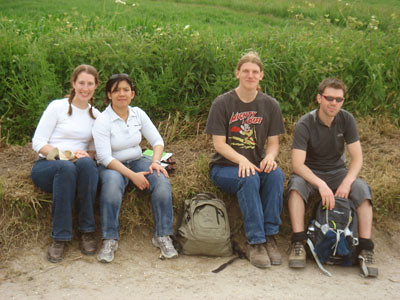
As well as alternately cheering Ali from the sidelines and expressing friendly disbelief at her ability to remain alive until the end of the 100km, I have donated a skein of handspun yarn to the fundraising prize draw being held over at Tripping Yarns.
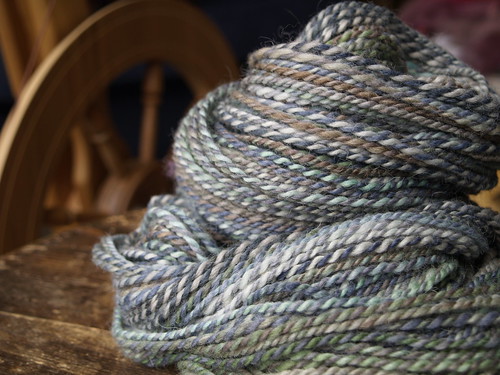
The appropriately named ‘Riverwalk’ fibre is from Spunky Eclectic, in Amy’s popular Corriepaca blend. The yarn is about worsted weight and measures 170m/4oz. I’ve spun it with a fair bit of air and it’s lovely and bouncy.
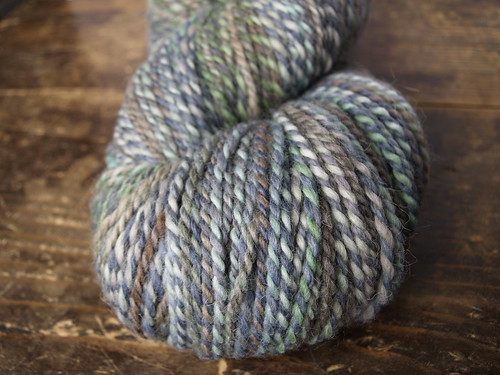
Please pop over and visit Team Geek’s fundraising page on Justgiving and make a donation to support this great cause and possibly win one of many fab yarny prizes. Also, keep an eye on the Team Geek Blog to see how the training is going, and all the other great stuff up for grabs.
Ciao!
 No Comments » No Comments »
 Posted by: Diane in IYNF
Posted by: Diane in IYNF
Part Five: Cashmere
Cashmere is one of the most renowned luxury fibres, with wonderful qualities of lightness, warmth and drape. It is the very fine under down of a goat, and can potentially be produced by any breed except the Angora (which produces mohair). Cashmere is a type of fibre, rather than a particular breed and refers to any goat down which meets the exacting grade of being less than 18.5 microns in diameter.
The finest Cashmere producing goats were traditionally found in Mongolia and other parts of central Asia, however, with careful breeding they are now becoming more common in many parts of the world. China, Mongolia and Iran are still the leading producers but there is a firm industry in Australia and New Zealand and production in the US and the UK is also increasing.
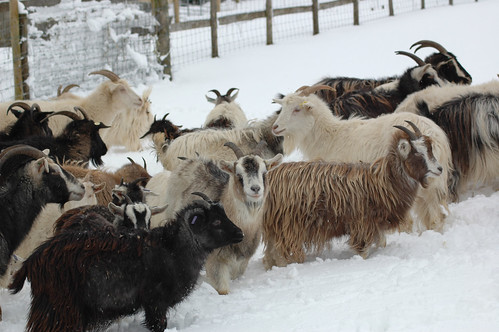
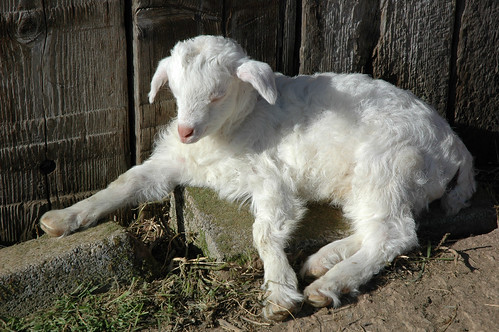
(Cashmere goats at Westcott Farm in Devon, photos by Lesley Prior)
Harvesting
Goats are shorn or combed once a year in the spring, a time when they will naturally shed the down grown for the cold winter months. In some areas, the shed fibre is collected from the rocks and bushes where the goats have been grazing. Each adult goat produces only a small amount of down, up to 8 ounces per year.
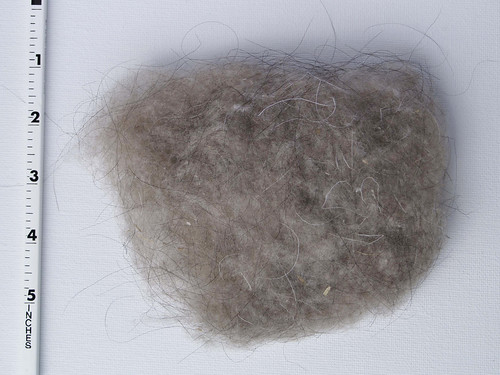
After washing, the fine down must be separated from the hairy outer coat and this is generally now done by machines. I de-haired a tiny amount of the fibre which Lesley kindly sent me and it took me about half an hour! Definitely a painstaking job. This labour-intensive process is one contributor to the high price of Cashmere fibre.
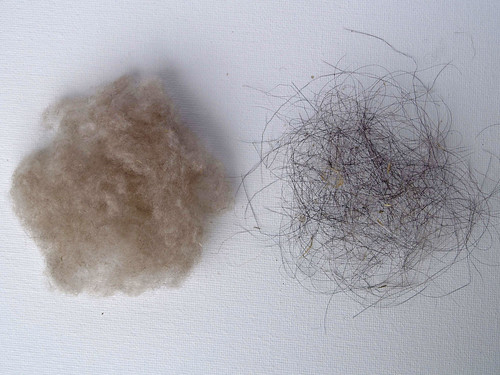
Structure and Characteristics
The finest Cashmere can have a diameter of as low as 14 microns, thus there can be still quite a range in quality between different sources of fibre. Poorly processed Cashmere may also still contain some guard hairs which will make spinning unpleasing, so be sure to obtain fibre from a reputable dealer.
Once it has been de-haired, the Cashmere down is processed in the same way as wool. It can be carded and sold as a ‘cloud’, or processed into top. Cashmere should be at least 1.25 inches long, and best quality Cashmere has a strongly defined crimp structure, making it springy and able to hold its shape. This crimp also contributes to the fibre’s warmth as it creates many air pockets in the yarn.
Cashmere has an indistinct, smooth scale structure and will not easily felt. With fulling, yarn or fabric made from cashmere will expand and ‘bloom’ creating a wonderful surface halo and soft handle.
Cashmere for Handspinners
Down fibres are generally best spun with a long-draw method and are popular with users of support spindles. A very light drop spindle (shown below, Bosworth featherweight - 14g), or a wheel set with minimal take-up will also be suitable and will not pull the yarn apart as you create it. The shortness and fineness of the fibres calls for a fair amount of twist, and low diameter. If you wish to create a thicker yarn, it will be more stable if you spin several singles and ply them together.
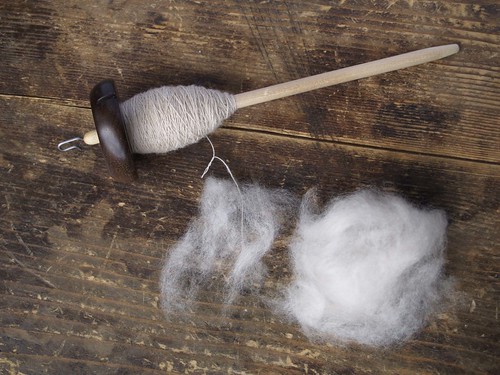
Cashmere blended with other fibres will add a lovely warmth and halo to your yarn and can make a small amount of expensive fibre go a lot further. Even the smallest proportion, 10% or less, is very noticeable in the handle of the finished yarn.
With special thanks to Lesley from Devon Fine Fibres who sent me the raw cashmere fibre and the gorgeous goaty pics!
Sources/further reading
MacKenzie McCuin, Judith ‘The Intentional Spinner’, Interweave press, 2009.
Albright, Barbara “The Natural Knitter�?, Potter Craft 2007
Russo, Robin. Class notes, SOAR 2008.
Devon Fine Fibres http://www.devonfinefibres.co.uk/
 2 Comments » 2 Comments »
 Posted by: Diane in General
Posted by: Diane in General
15 mins till the cab arrives to take us off to the sunny Turkish coast (via Heathrow actually). Will miss you all dearly, but I have relaxing to do and olives to nibble. I’ll be back on Sunday 10th with a Spin-in post, Lingr, and maybe even some pictures of me in a bikini (white skin alert).
If you have a burning question in the meantime, pop by Ravelry and post it on my group. There’s plenty of helpful folks who can answer it for you there in my absence.
See you soon, and to everyone in the UK, have a great Bank Holiday weekend!
 3 Comments » 3 Comments »
This was my third visit to Wonderwool, and it just keeps on getting better! I drove up to Wolverly with Ali and Nick and we stayed with Nick’s folks in their lovely old old farmhouse (which is now in the middle of the suburbs of course). From there it was only a fairly quick run over to Builth and with the addition of Yoshimi in the back seat, she’d joined us Friday night, it seemed like no time before we were squeeing at the sheeps!
There was way more fibre there this year, which is good as I’d made a firm rule about not buying any more yarn. The rules about fibre and spindles, however, were (ahem) a little less firm, shall we say. I started off with a dash to The Natural Dye Studio, as Amanda was holding a few silk packs for me to pick from (thanks Queenie!) and then we wandered around and around only semi-systematically until we figured we’d seen most things ran out of money.
Fibre:
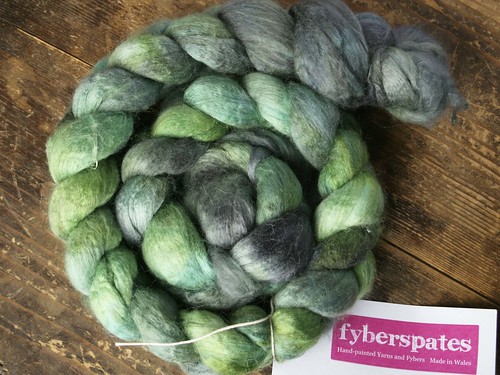
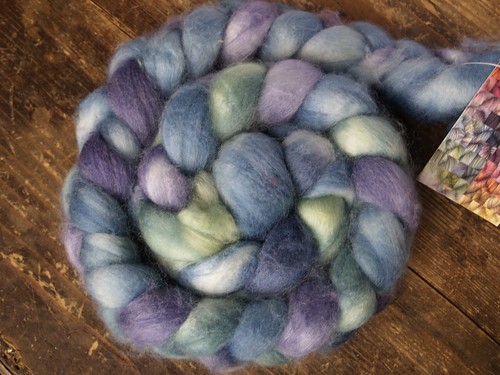
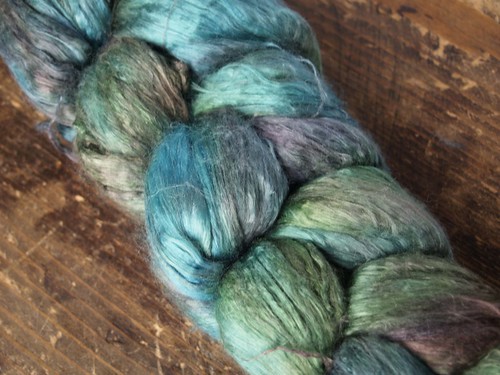

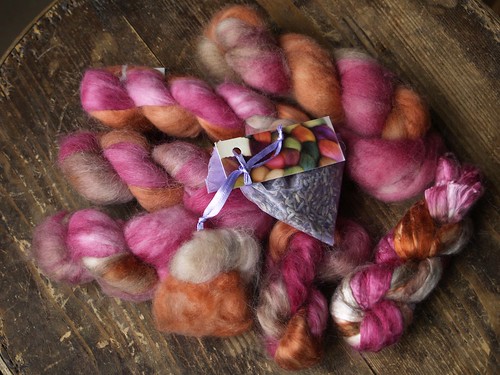

Top to bottom: Fyberspates Merino/Silk, NDS Merino/Bamboo, Silk Brick from Oliver Twists, Artist’s Palette Merino, half a Spindlefrog luxury spinners set (I shared with Sarah), and of course, NDS Precious Tussah Silk (mmmmmm).
This was totally Sarah’s fault, still not sure how I ended up with it:

A lovely black/grey merino fleece from the Coloured Sheep Breeders Association, which we also shared.
And, well, Bossies are going to be hard to get soon so it seemed an intelligent decision:
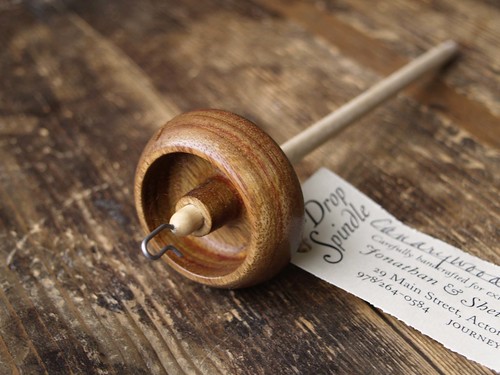
16g of lovely Canarywood Bossieness.
The best part of course, was meeting up with people and chatting and catching up and nosing out their purchases! I met Megan for the first time in real life, which was fab. Also connected with Kerrie, Helen and Lucy who crashed with us at the pub later on where we took over an entire corner and scared everyone away with the yarny activities (I still think the owner chose to come out and sit in the bar just so he could watch us in fascination).
Wonderwool was so much fun that I think that this year I really need to make the effort to get up to Woolfest as well. Are you going to be there??
 10 Comments » 10 Comments »
 Posted by: Diane in General
Posted by: Diane in General
There has been some busy scheduling going on, and there are lots of classes coming up in the next couple of months here in London. Looking forward to seeing some new faces, and maybe some old friends as well!
Classes at Stash Yarns in Putney
Superspin 1 Tuesday 9th and 23rd June, 10am-1pm
Call 020 8246 6666 to book
Classes at Socktopus in Chelsea Harbour
Luxury Fibres Saturday 16th May, 10am - 1pm
Spin Short Saturday 16th May, 2pm - 5pm
Single Spun Sunday 17th May, 10am - 1pm
Introduction to Spinning Sunday 17th May, 2pm - 5pm
Superspin 1 Sunday 21st June and 12th July, 2pm-5pm
Superspin 2 Sunday 21st June and 12th July, 10am-1pm
Click here to book
More information about each class is available on the Classes page, although not all these dates are up there yet.
I’ll also be teaching at the UK Ravelry Day on June 6th in Coventry. Due to popular demand, Jo and I have opened up some more places in the Introduction to Spinning class on the day. More information on the UKRD website.
 No Comments » No Comments »
 Posted by: Diane in IYNF
Posted by: Diane in IYNF
Part Four: Mohair
Mohair is the fibre obtained from the Angora goat, named for the region in Turkey where they were first domesticated. The fibre is well known for its incredible shine and beautiful fluffy halo. It’s no wonder: the word Mohair derives from the Arabic word ‘mukhayyar’, meaning choice or select.
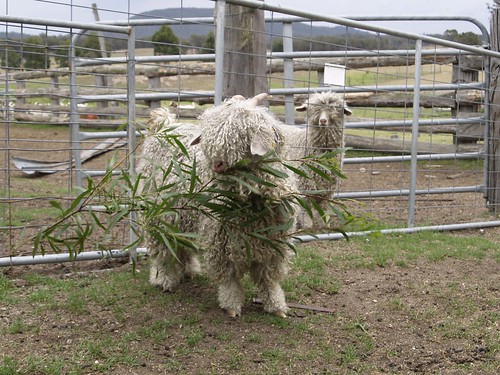
(Daisy, just before shearing)
Angora goats (actually recently renamed Mohair goats) are friendly and docile and make lovely fibre pets! Although originally kept closely guarded and protected in Turkey, the breed was eventually exported in the 19th century and the goats are now farmed in many parts of the world including Africa, the United States and Australia.
Harvesting
Mohair grows very quickly (about one inch per month) and Angora goats are generally shorn twice a year, in the spring and autumn. Although goat hair contains no lanolin, it does have natural oils which are easily washed out with mild soap. Mohair is generally carded before spinning and is often blended with other fibres to add strength and lustre to a mix.
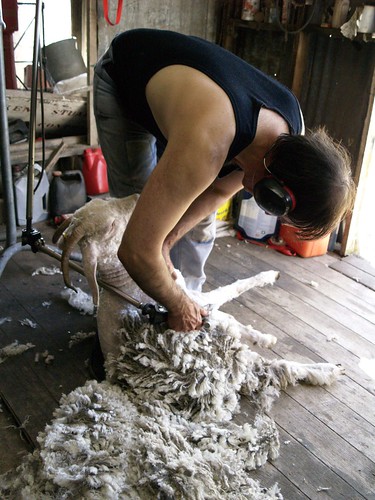
Structure and Characteristics
Mohair has a very smooth surface, lacking the scales found on wool. This smoothness reflects light, giving mohair its incredible lustre. The fibres are long and straight, with a curly wave. Young kids usually develop close ringlets, a sign of fineness, this curl becomes less pronounced as the goat ages.

(Adult mohair - top, and kid)
Unlike sheep and many other fibre animals, Mohair goats produce different qualities of fibre as they get older. Finest kid mohair comes from the first, second and occasionally third clips, fibres are between 23 and 30 microns. This is the best fibre for knitting yarn, it is soft and produces a lovely halo. Clips from older goats can range up to 40 microns. As the strength and lustre of the fibre increases with age, these grades are excellent for upholstery fabrics or to blend with other fibres to add strength and shine.
Varieties
The different Angora goat varieties (including for example, South African and Australian strains) have only subtle distinctions. However, there has been much interest in recent years in developing naturally coloured Angora goats, and fibre can now be obtained in a range of colours including greys, blacks and reds. For more information, visit the Colored Angora Goat Breeders Association.
Mohair for Handspinners
Mohair is a fibre which many spinners avoid, partly because they fear it will be ‘difficult’, partly due to experience with prickly mohair, and perhaps partly because they’re just not quite sure what to do with it! I have to admit to being a little bit in love with Mohair. Having access to a flock of the cutest goats on the planet helps of course, and I also love the incredible jewel colours mohair gives and the subtle halo effect that can be created.
The smoothness of mohair, which gives it its shine, does make it a very slippery fibre to work with. It needs a lot of twist to hold it together if spun on its own, but once there is enough twist, the fibres will lock safely in place and the ends will pop out and bloom.

(carded Mohair rolag ready for spinning)
I personally prefer to blend mohair with other fibres, usually wool. It is fabulous in socks for a bit of extra warmth and strength (see my Jo pattern and tutorial in Spin! Series 1), and is gorgeous blended with wool in a woven project where it adds lustre and drape to the fabric.
Card or blend mohair with handcards, and spin fine yarns with a fairly high level of twist. Mohair has no memory, so avoid using it straight up for garments which might sag and stretch. Also, use a larger knitting needle size, or weaving sett, to ensure that the mohair fibres have room to bloom.

* With thanks to Daisy, Bonsai and the rest of the flock at the farm for posing for photos and giving up their fleeces for us again this year!
Do you have questions? What are your experiences with Mohair – like it? Love it? Leave a comment or come by the Lingr chatroom on Sunday evenings.
Sources/further reading
MacKenzie McCuin, Judith ‘The Intentional Spinner’, Interweave press, 2009.
Albright, Barbara “The Natural Knitter�?, Potter Craft 2007
Russo, Robin. Class notes, SOAR 2008.
http://www.cagba.org/ Colored Angora Goat Breeders Association
 6 Comments » 6 Comments »
Just before I left for Australia (literally that morning) I got this fabulous DVD by Jacey Boggs of Insubordiknit in the post. I tossed it in my bag and took it with me, mentally adding it to the list of spinny things to do while hanging out with my mum.

I didn’t really know what to expect, although I’ve seen Jacey’s work around and knew that the content of the DVD would probably not be leaning towards the conservative - I wasn’t wrong! Coils, slubs, beads, loops, foreign objects, you name it, it’s in there. And the DVD production is top quality, with great navigation menus, on-screen tips and plenty of excellent camera angles.
A word about Art Yarns. It really bugs me when people say to beginners “Oh don’t worry - what you’re spinning is Art Yarn - lol!” Saying this about beginner yarn diminishes the incredible skill that someone like Jacey needs to produce the yarns included in this DVD. Watch a short clip and you’ll soon see that these techniques are not something you’ll be an instant expert at. In fact, one of the first things Jacey says is to put down the DVD and come back later if you’re not an experienced spinner. I love that she is honest about the skills required and doesn’t try to either mislead people about the content, or dumb down the techniques for the less experienced. With so much around now for beginner spinners, it’s refreshing to find something that’s really aimed at the more advanced.
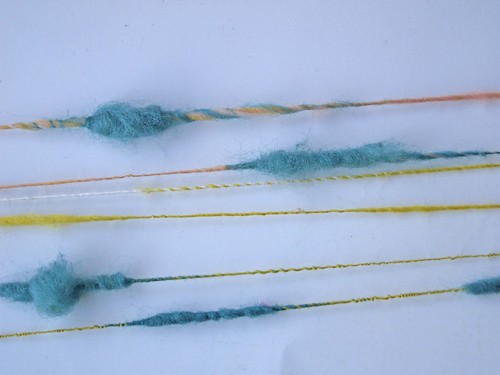
Each set of techniques is grouped in the DVD and nicely organised so they build on each other. So, later down the line when doing coils, you might be using a technique you learnt back in segment one. For the first watching at least, I’d definitely recommend sitting through the whole DVD in order to get a sense of all the different skills, then gather your materials and have a go at the ones that appeal to you most.
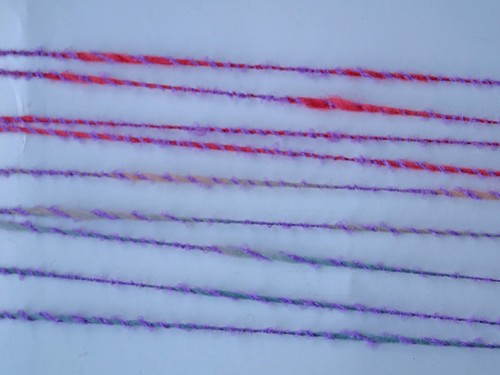
Jacey speaks clearly, and not too fast, explaining the techniques, wheel set-up and materials very clearly. At the same time, dot points pop up on the screen to help the core skills sink in. She repeats each technique several times, with a close-up camera angle, and you can even set the DVD to loop the clip over and over for each technique. The instructions were so clear and memorable that Mum and I were able to try out some of the techniques the next day before watching a second time, although we did ask each other a lot of questions!
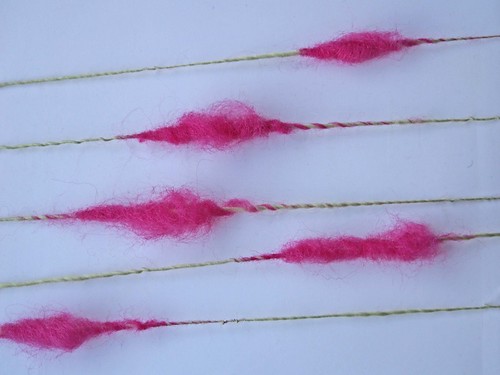
Jacey has two friends with her in the DVD, working on the same techniques but including some modifications which were interesting to learn about. For example, one of the spinners had a small oriface and Jacey pointed out several times the modifactions needed for a particular technique in this case. I was disappointed, however, that we didn’t really get to see much of the other spinners working. At least a couple of times, Jacey mentions what one of the others is doing, but we don’t get a chance to see it close-up and compare to the main yarn. I also found myself wondering several times which wheel direction was used. From watching closely, it appears that Jacey uses the standard spin-z ply-s convention, but in a few places I would feel more comfortable with a confirmation on this, especially where plying singles with threads etc.

Overall, I strongly encourage any spinner looking for some new learning to get this DVD. The bright, funky yarns may not be to your personal taste (and you all know that I am definitely Miss Conservative when it comes to handspun), but even if you don’t see yourself creating yarn with halos or eyeballs, look beyond that to the fantastic techniques that are covered. There are definitely yarns in there that I will spin, and there are loads and loads of techniques which are applicable in other yarn types and which I am now really keen to master.
Thanks Jacey for a great resource! Learn more at www.insubordiknit.com
(Photos from top: cocoons by Mum, racing stripes by Mum, cocoons by me, beehive coils by me. Please note, these are our first attempts!!)
 8 Comments » 8 Comments »
|
































 Entries (RSS)
Entries (RSS)